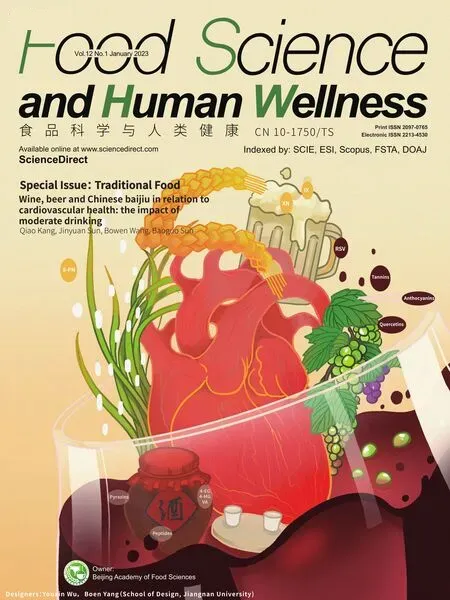Effect of different drying methods on the taste and volatile compounds,sensory characteristics of Takifugu obscurus
2023-01-22YouyouLiShuiJingYiwenZhuWenzhengShiYinZhngYunLiu
Youyou Li, Shui Jing*, Yiwen Zhu Wenzheng Shi, Yin Zhng, Yun Liu*
a College of Food Science and Technology, Shanghai Ocean University, Shanghai 201306, China
b Department of Food Science & Technology, School of Agriculture and Biology, Shanghai Jiao Tong University, Shanghai 200240, China
c Key Laboratory of Meat Processing of Sichuan, Chengdu University, Chengdu 610106, China
Keywords:Hot air drying Microwave vacuum drying Hot air-assisted radio frequency drying Takifugu obscurus Quantitative descriptive analysis
A B S T R A C T Pufferf ish is prone to deterioration due to abundant nutrients and high moisture content. Drying technology can extend the shelf life and enhance the f lavor quality of aquatic products. The study investigated the effect of hot air drying (HAD), microwave vacuum drying (MVD) and hot air assisted radio frequency drying (HARFD)on the taste and volatile profiles of Takifugu obscurus. Different drying methods had significant influence on the color, rehydration, 5′-nucleotides, free amino acids and volatile components (P < 0.05). The results showed that HAD and HARFD could promote the f lavor of T. obscurus by producing higher equivalent umami concentration (EUC) values, which were about two times of MVD group, and more pronounced pleasant odor according to sensory analysis. HAD is more appropriate for industrial application than HARFD and MVD considering the economic benef its. This study could provide a reference for the industrial application of drying T. obscurus.
1. Introduction
Takifugu obscurusis a kind of pufferfish popular in Eastern Asia for its desirable taste and high protein content. In addition,T. obscurushas a prominent economic value with the advantages of large shape and rapid growth [1]. However, high moisture content vand abundant nutrients inT. obscurusstimulate microbial activity and cause thedeterioration of muscle. It was demonstrated that the shelf life of freshT. obscurusis only about 4 days under refrigerated storage [2]. Drying is proposed to prolong the shelf life of f ishes by inhibiting microorganism’s growth and enzyme activity [3]. Sun drying is a traditional and time-consuming method, influenced by uncontrolled environmental factors: climate, insect and bacterial [3].Therefore, exploring effective drying technologies to process theT.obscurusis essential.
Currently, hot air drying (HAD) and microwave vacuum drying(MVD) have been widely used to dry aquatic products [4-6].Rehydration, nutrition, color, and flavor of products are affected by different drying methods. It was reported that HAD provided“caramel” and “roast/nutty” aroma to shrimps (Penaeus vannamei) [7].Fu et al. [4] reported that HAD removed the “f ishy off-odor” of silver carp; MVD removed the “earthy-musty off-odor” of silver carp. In addition, HAD and MVD could significantly increase the content of total amino acids in shiitake mushrooms [8]. Radio frequency technology generates heat based on intermolecular friction through ion migration and dipole rotation. Compared with microwave, radio frequency has the advantages of stronger penetrating power and more stable temperature control [9]. Hot air assisted radio frequency(HARFD) could improve drying uniformity and has been applied in drying of various food, such as nuts, fruits and vegetables [10-12].However, the rare study on f ish dried by HARFD was reported, in our study, HARFD was f irst used in the drying ofT. obscurus.
The effect of drying methods on physicochemical characteristics,nutrition and volatile compounds of fish have been reported [4,5,13].Until now, to the best of our knowledge, little is known regarding the flavor of driedT. obscurus. The purposes of this study were: (1) to determine and compare the proximate composition, color, rehydration,taste components and volatile compounds of driedT. obscurusby HAD, MVD and HARFD; (2) to select an appropriate drying method forT. obscurusbased on the flavor profile of dried products.
2. Materials and methods
2.1 Materials and reagent
Two-year-oldT. obscuruswere purchased from Zhongyang Co.,Ltd. (Jiangsu Province, China) in August 2020. TheT. obscuruswere gutted by the professional slaughterers, and the weight and length of the individual fish were (333.28 ± 15.73) g (without viscera) and(27.12 ± 0.62) cm. TheT. obscuruswere transported under the ice to the laboratory and preserved at -20 °C. Before processing, the fish were thawed at 4 °C. Then the thawed fish were decapitated, and the dorsal muscles were uncut-sliced along the vertical direction of the spine using a scalpel. The pretreated fish were randomly divided into three groups for subsequent drying treatments.
Potassium dihydrogen phosphate (KH2PO4, AR) and ethanol absolute (purity ≥ 99.8%) were obtained from Shanghai Lingfeng chemical reagent Co., Ltd. (Shanghai, China). Sodium hydroxide(NaOH, GR), trichloroacetic acid (AR), phosphoric acid (GR) and methanol (HPLC grade) were purchased from Aladdin biochemical technology Co., Ltd. (Shanghai, China). Hydrochloric acid (AR) and perchloric acid (GR) were purchased from Shanghai Titan Scientific Co., Ltd. (Shanghai, China). 5′-nuclotides (purity ≥ 99.99%) and lactic acid standards (HPLC grade) were obtained from Sigma-Aldrich (St. Louis, MO). Succinic acid (purity 99.5%) standard was purchased from Dr. Ehrenstorfer GmbH. (Shanghai, China).2,4,6-trimethylpyridine (purity ≥ 98.29%) standard was purchased from Ark Pharm, Inc. (Chicago, USA).
2.2 Drying methods
2.2.1 Hot air drying
The fish were dried with hot air in a chain oven (YLD8, Fulaixin Catering Equipment Co., Ltd., Shanghai) equipped with a blower. Hot air was continuously blown into the oven and dried the fish on the stainless-steel net plate. The temperature was set at 60 °C based on previous studies [14,15], which reported that it is favourable to obtain better quality and oxidative stability of fish at 60 °C. The air velocity was detected by an anemometer (AR816, Hong Kong Xima Smart sensor Co., Ltd., China), and the actual air velocity was (1.5 ± 0.1) m/s.The drying process lasted for 16 h.
2.2.2 Microwave vacuum drying
A microwave vacuum dryer (AVD-1, supervised by Jiangnan University) with an output power of 0-1000 W and an operating frequency of 2 450 MHz was used for drying. The temperature inside the oven could be read on the dryer. Based on the previous study [4]and preliminary experiment, the microwave power was set at 350 W to ensure that the drying temperature was 55–60 °C during the drying processing. The vacuum degree was set at 0.09 MPa. The fish were placed in the center of a glass plate rotated at a constant speed. The total drying time was 4 h.
2.2.3 Hot air assisted radio frequency drying
A 12 kW, 27.12 MHz parallel electrodes type radio frequency dryer (GJD-6A-27-JY, Huashijiyuan Co., Ltd., Hebei, China) with a built-in heating system was used. The parameter was selected based on the method described by Gong et al. [12] with slight modification of electrode gap. The optimal electrode gap was set at 10 cm considering the heating uniformity, drying efficiency and product quality. The heating temperature was set at 60 °C. The fish were evenly placed on a rectangular ceramic plate (20.5 × 32 cm2)with holes. The fish meat temperature was detected in real time by five optical fiber sensors (Xi’an Heqiguangdian Co., Ltd., Shaanxi province, China). The total drying time was 14 h.
All the moisture contents of fish products obtained by three drying methods were ≤ 22% according to China agricultural industry standard (NY/T1712-2018) [16].
2.3 Analysis methods
2.3.1 Proximate analysis
The moisture, crude protein, fat and ash contents were determined as described by the Association of Official Analytical Chemists(AOAC) [17]. The moisture content was measured by the oven drying method. The fish sample (2.000 0 g) was placed in a glass weighing bottle and heated to a constant weight in the oven (DHG-9240A, Shanghai Jinghong Equipment Co., Ltd., China) at 105 °C.The kjeldahl apparatus (KjeltecTM8100, FOSS, Sweden), soxhlet extraction system (Scino ST 310, FOSS, Sweden) and muffle furnace(SX2-4-10, Shanghai Bozhen Instrument Co., Ltd., China) were used to analyze the crude protein, fat and ash contents, respectively.
2.3.2 Rehydration ratio
The 1 cm3fish cubes used for rehydration in three drying groups were taken from the same part of the dried fish body. These cubes were accurately weighted and placed separately into beakers containing 60 mL of distilled water at 40 °C. The cubes were removed out every hour and placed on a piece of filter paper at the same time, and the Kimwipe paper was used to soak the surface water before weighting. It was regarded as the constant weight when the difference between the two weights was less than 0.000 2 g. The rehydration ratio was calculated according to Eq. (1) [18]:

WhereRrwas the rehydration ratio,WrandWdwere the sample weight after and before rehydration, respectively.
2.3.3 Color measurements
The color was measured using a colorimeter with a D65 illuminant (LabScan XE, HunterLab, USA). Firstly, the colorimeter was calibrated with standard black and white ceramic plates. Then the 1 cm3fish cube was placed in the center of a glass vessel. The glass vessel was covered by a black plastic cylindrical lid with the same diameter as the illuminant to avoid interference from external light.The color difference ( was calculated using Eq. (2) [9]:

WhereL*,a*,b* expressed the lightness, redness, yellowness of dried fish sample, respectively.L0*,a0*,b0* referred to the color reading values of fresh fish sample.
2.3.4 5′-Nucleotides determination
The sample pretreatment was carried out according to the method of Zhang et al. [19] with some modification. The dried sample (5 g)was homogenized with 20 mL 10% perchloric acid, and then was ultrasonically extracted for 10 min. Subsequently, the centrifugation was performed at 4 °C, 9 500 r/min for 15 min. The above operation was repeated, then the supernatants were combined and its pH was adjusted to 5.8 with 5 mol/L NaOH. Before the liquid chromatography(LC) analysis, the sample was diluted to 50 mL and filtered with a 0.22 μm filter membrane. LC system (LC-20AR, Shimadzu, Japan)coupled with a C18column (4.6 mm × 250 mm, 5 μm, Shim-Pack GIS)was used for separation. The mobile phase A and B were methanol and 25 mmol/L KH2PO4, respectively. The flow rate was 1.0 mL/min.The elution program was as follows: 100% B for 5 min, decreased to 95% from 5 min to 14 min, continually decreased to 70% from 14 min to 25 min, and then came back to 100% in 5 min and kept for 9 min. The injection volume was 20 μL. The detection wavelength was 254 nm.
2.3.5 Free amino acids (FAAs) analysis
The sample pretreatment was carried out according to the method of Zhang et al. [19]with slight modification. The dried sample (2 g)was homogenized with 15 mL hydrochloric acid (0.01 mol/L) and then extracted for 30 min in the ultrasonic water bath. Then the sample was centrifuged at 10 000 r/min for 15 min at 4 °C. The above steps were repeated and the mixed supernatant was diluted to 25 mL.Then 10 mL supernatant was mixed with 10 mL trichloroacetic acid (10%,V/V) and kept under room temperature for 1 h, and the mixture was centrifuged at 9 500 r/min at 4 °C for 10 min. The new supernatant was adjusted to pH 2.2 with 6 mol/L and 1 mol/L NaOH,and then was diluted to 25 mL, finally was filtered with a 0.22 μm filter membrane. The amino acid analyzer (L-8800, Hitachi Co.,Ltd., Tokyo, Japan) was used to analyze the sample solution, and the Inertsil ODS-3 C18column (4.6 mm × 150 mm, 7 μm, GL Sciences Inc. Tokyo, Japan) was used for separation.
2.3.6 Organic acids
The dried sample (1 g) was homogenized with 10 mL pure water for 1 min and then centrifuged at 9 500 r/min for 20 min at 4 °C. The supernatant was filtered through a 0.45 μm membrane filter before analysis by LC. The LC and column were the same as above used in 5′-nucleotides determination (section 2.3.4). The LC conditions were as follow: eluents A and B were methanol and 0.1% phosphoric acid, respectively; the elution program was as follow: 97.5% B for 5 min, decreased to 90% from 5 min to 10 min and kept for 5 min,and then came back to 97.5% from 15 min to 20 min and kept for 10 min; the injection volume was 10 μL; the flow rate was 1.0 mL/min;the detection wavelength was 210 nm.
2.3.7 Taste activity value (TAV) and equivalent umami concentration (EUC)
TAV refers to the ratio between the concentration determined of taste compound and the threshold value, which are generally measured in water. Compounds with TAV values greater than 1 are considered as the active-taste compounds [20].
EUC expressed the concentration of monosodium glutamate(MSG) equivalent to the umami intensity given by the mixture of umami amino acids and 5′-nucleotides [21], it was calculated by the following Eq. (3):

WhereYwas the EUC expressed as g MSG/100 g;aiwas the concentration of the umami amino acid (Asp or Glu);biwas the relative umami concentration (RUC) for each umami amino acid(Asp, 0.077; Glu, 1);ajwas the concentration of umami 5′-nucleotide(5′-GMP, 5′-IMP or 5′-AMP);bjwas the RUC for each umami 5′-nucleotide (5′-GMP, 2.3; 5′-IMP, 1; 5′-AMP, 0.18); 1 218 was the synergistic constant.
2.3.8 SPME-GC/TOFMS
SPME procedure was carried out based on the method of Wu et al. [22] with some modification: 2 g of the dried sample was placed into a 15 mL headspace vial. Then 15 μL of 10 mg/L of 2,4,6-trimethylpyridine dissolved in ethanol were added into the vial as the internal standard solution. The sample in the vial was equilibrated at 55 °C for 15 min, and the extraction was carried out at the same temperature for 50 min. The fiber (50/30 μm DVB/CAR/PDMS, length 2 cm, Supelco, Inc., USA) was selected to extract the volatile compounds of three driedT. obscurus. Desorption was operated at 220 °C for 6 min.
An Agilent 7890B gas chromatography coupled with a mass spectrometer (Pegasus BT, LECO., USA) was used to identify volatile compounds of three driedT. obscurus.The DB-5MS column(30 m × 0.25 mm, 0.25 μm, Agilent Technologies Inc., Palo Alto, CA,USA) was used for separation. The initial temperature of GC oven was 40 °C and held for 2 min, and then increased to 160 °C at the rate of 4 °C/min, finally increased to 250 °C at 10 °C/min rate and held for 5 min. The high purity helium (purity 99.99%) was used as the carrier gas at a linear flow rate of 1.2 mL/min. The mass spectrometer was operated in the electron impact (EI) ionization mode (70 eV) and the ionization source temperature was 230 °C, mass scan range was from 35 to 550m/z.
2.3.9 Sensory evaluation
Quantitative descriptive analysis (QDA) was used to evaluatethe appearance and odor of driedT. obscurus. Ten trained panelists(7 females and 3 males, aged 22 to 30) were recruited from the School of Agriculture and Biology at Shanghai Jiao Tong University. They had accumulated more than 60 h experience in QDA of various food samples. The experiment consisted of three training sessions (45 min for each) and a testing experiment. In the first two training sections,descriptive terms regarding the appearance and odor of three driedT. obscuruswere developed by panelists. In the third training section,panelists were provided with reference samples of the controversial descriptors in the previous training sections to reach an agreement.Meanwhile, the panelists were trained to evaluate attributes on a 15 cm line scale.

Table 1 Proximate compositions and the rehydration ratios of MVD, HAD, HARFD and fresh T. obscurus.
In the testing period, panelists evaluated the dried fish samples in isolated sensory booths with white light. Before testing, two cubes (1 cm3) of each sample were placed in a sealed cup (27 mL),labeled with random three-digit codes and kept for 30 min under room temperature. An online questionnaire platform (Changsha Ranxing Information Technology Co., Ltd., China) was used to create the sensory questionnaire. Panelists assessed sensory attributes by dragging the slider on the 100-point line scale.
2.3.10 Statistical analysis
The 5′-nucleotides and FAAs were performed in quadruplicate,other tests were performed in triplicate. All the data were shown as mean ± SD (standard deviations). The statistical analysis was performed by using the software IBM SPSS version 25 (SPSS Inc., Chicago,USA). The significant differences were carried out using one-way ANOVA (Tukey’s multiple range tests), andP< 0.05 was considered as a statistically significant difference. Principal component analysis(PCA) was performed by XLSTAT 2016 (New York, USA).
3. Results and discussion
3.1 Effect of drying methods on proximate composition,rehydration ratio and color
The proximate composition and the rehydration ratio of three driedT. obscuruswere presented in Table 1. The moisture content of three driedT. obscurusranged from 18.58% to 19.20% (wet weight).The content of crude protein, ash and fat significantly increased after drying based on wet weight (P< 0.05). For the content of ash, no significant difference was found among fish dried by three methods.The fat content was highest in the HAD group (0.7 mg/100 g)(P< 0.05), followed by HARFD (0.61 mg/100 g), and MVD group(0.5 mg/100 g). No significant decrease in crude protein, ash, lipid contents (dry weight) of three dried groups compared with the fresh group was found, indicating that these three dried methods had no negative effect on the proximate components.
Rehydration indicates the restoring power of dry materials in water [23]. MVD group had the highest rehydration ratio (1.80),which can be caused by the porous structure of muscles formed during the rapid diffusion of water vapor in microwave drying [24].The rehydration ratios of HAD (1.43) and HARFD (1.50) groups were lower than that of MVD group, probably due to dense structure caused by collapsed capillaries reduced the rehydration ability [8].
The color parameters of fresh and driedT. obscuruswere presented in Table2. The lightness values of HAD and HARFD groups were significantly lower than MVD and fresh groups (P< 0.05).The lightness was related to the surface protein structure change [14],and no significant difference was found between the MVD and fresh groups (P< 0.05), indicating that less surface protein denaturation occurred in MVD group. The significant difference in the redness existed among three dried groups (P< 0.05). Negative redness (–a*),expressed greenness [13], was observed in fresh and MVD groups.Different from redness, there was no significant difference in yellowness among the three dried groups. MVD group had the smallest ΔEvalue (7.66 ± 0.43), indicating that the color of MVD sample was closed to the fresh group.

Table 2 The color parameters of MVD, HAD, HARFD and fresh T. obscurus.
3.2 Effect of drying methods on free amino acids,5′-nucleotides, organic acids and EUCs
As shown in Table 3, the total FAAs contents significantly increased in HAD group and decreased in MVD group after drying(P< 0.05), no significant change was found in HARFD group. The enzymatic reaction was reported to increase the water-soluble protein content of shiitake mushrooms because of partial degradation and structure variation at the initial period of hot air drying. Later, the protein degraded to small oligopeptides and amino acids with drying continued [25]. In our study, the crude protein content in HAD group was the lowest, indicating that HAD could promote protein degradation and thereby produced a higher level of FAAs. Moreover,the MVD group showed the lowest FAAs content (8.17 mg/g) since microwave radiation could reduce the activities of enzymes that play major roles in protein degradation [26]. Several researchers reported that short drying time may also lead to lower amino acid content [26,27].
FAAs contribute strong umami and sweet taste to seafood [28].According to the taste characteristics, FAAs could be divided into three classes: umami free amino acids (UFAAs), sweet free amino acids (SFAAs) and bitter free amino acids (BFAAs) [29]. HAD group obtained the highest contents of three kinds of taste FAAs, followed by the HARFD group and MVD group (Table 3). Asp and Glu represent as UFAAs [26], and the TAVs of Glu in HAD and HARFD groups were > 1, suggesting that Glu contributed to the umami taste in these two groups. Gly, Ala and Arg were the major SFAAs, and the TAV values of Ala and Arg were > 1 in three dried groups. Ala and Gly were also identified taste-active compounds in snow crab [20]and oyster [30]. The TAV value of Gly in HAD group was 1.13.Therefore, Gly was also one of the most taste-active compounds in HAD group. BFAAs accounted for about 50% of total FAAs,Lys with a bitter taste and slightly sweet taste [20] predominated in BFAAs in our study (TAV > 1). However, the TAVs of other BFAAs including Leu, Ile, Tyr, Phe and His were < 1, indicating the little influence of them on the taste.
Drying methods significantly affected the contents of 5′-IMP,5′-GMP and 5′-AMP (P< 0.05), Table 4 showed that 5′-IMP was the dominant nucleotide in all dried groups, and the contents of 5′-IMP in HARFD and MVD groups were significantly higher than that in HAD group (P< 0.05). The TAV values of 5′-IMP of three dried groups ranged from 7.42 to 14.44, indicating that 5′-IMP had an important effect on the taste of driedT. obscurus. MVD group had the highest 5′-GMP content. The contents of 5′-AMP in MVD and HARFD groups were 7.5 and 9 times higher than that in HAD group,respectively. 5′-GMP, 5′-IMP and 5′-AMP contribute to umami and sweetness of aquatic products [20,29]. 5′-GMP is an umami enhancer and contributes to meaty flavor [31]. 5′-IMP and 5′-AMP could increase the umami, sweet and complexity by synergistic interaction in the synthetic extract imitating boiled prawn, besides, the omission of 5′-IMP decreased the umami taste of synthetic seafood extracts,such as sea urchin and dried skipjack [32]. 5′-AMP was reported to contribute sweetness and inhibit bitterness [33].
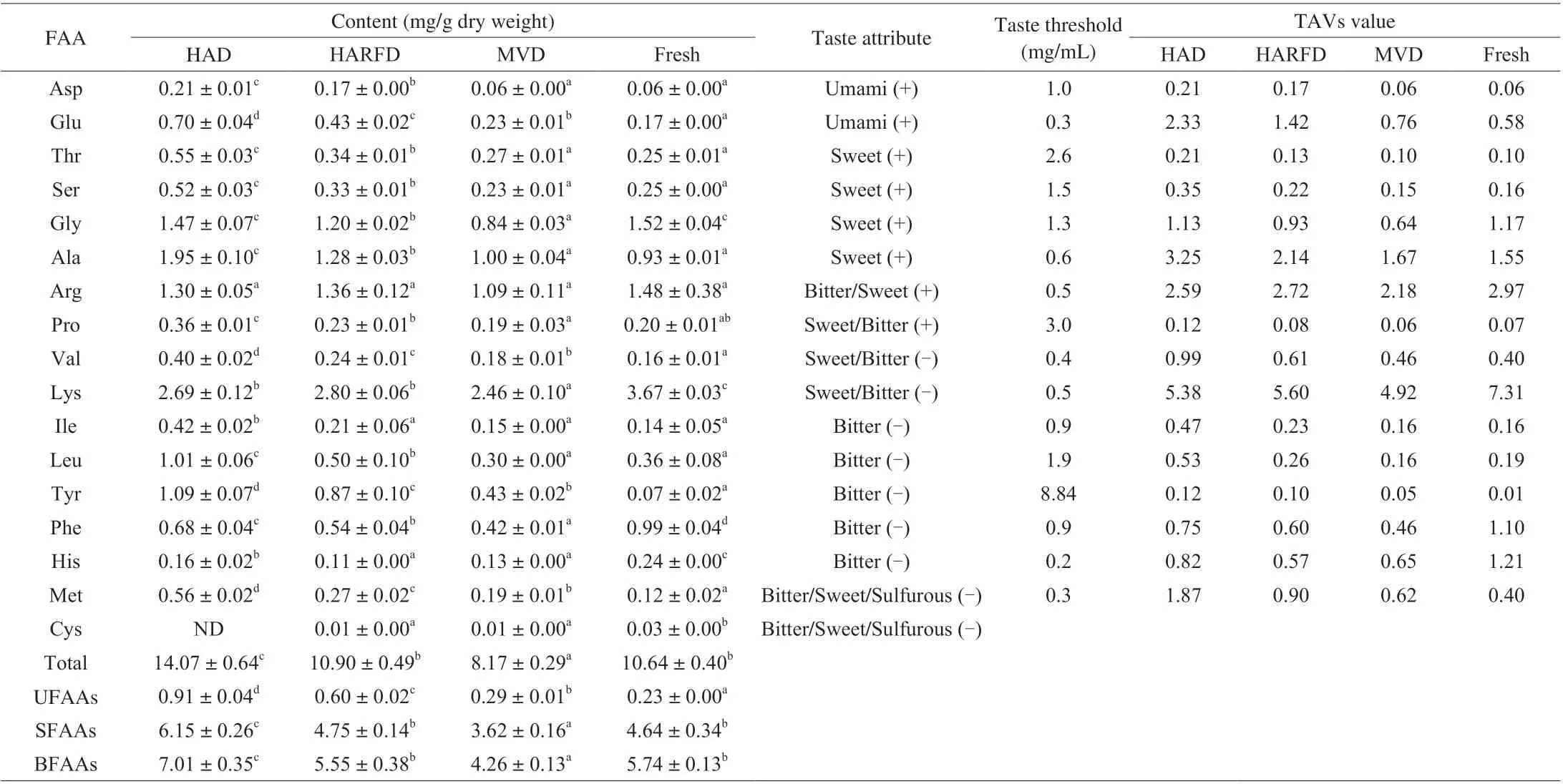
Table 3 The contents, taste threshold and the TAVs of FAAs in MVD, HAD, HARFD and fresh T. obscurus.

Table 4 5′-Nucleotide composition and lactic acid of MVD, HAD, HARFD and fresh T. obscurus.
On the other hand, synergistic interaction between 5′-nucleotides(5′-GMP, 5′-IMP and 5′-AMP) and amino acids (Glu and Asp)could increase the umami taste [34]. As shown in Fig. 1, the EUC values of MVD, HAD and HARFD were 10.31, 17.32 and 19.81 g MSG/100 g, respectively, which were significantly increased compared with the fresh group (5.20 g MSG/100 g) (P< 0.05). In addition, the EUC values in three dried groups were higher than that of steamedT. obscurus(2.65 g MSG/100 g) and boiledT. obscurus(1.07 g MSG/100 g) [19], suggesting that drying could promote the umami intensity ofT. obscuruseffectively. Umami taste is the important characteristic ofT. obscurusflavor, therefore, HAD and HARFD have more advantages in obtaining high EUC value compared with MVD.
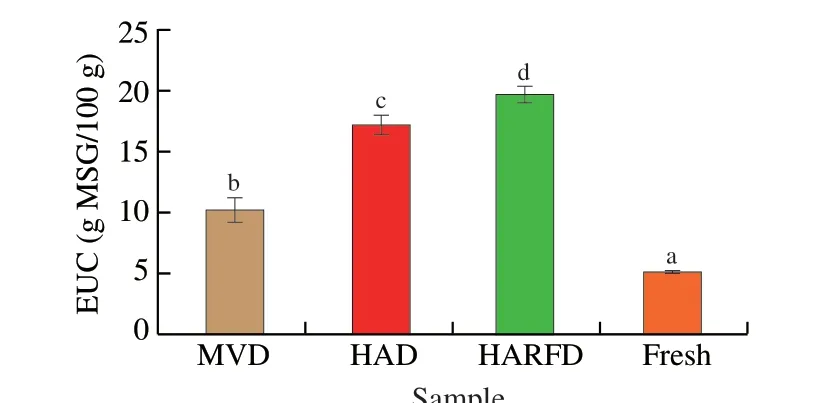
Fig. 1 EUC values for MVD, HAD, HARFD and fresh T. obscurus. Different letters indicate significant differences (P < 0.05).
The lactic acid contents of three dried fish samples were listed in Table 4. We found the highest lactic acid existed in HAD group
and there was no significant difference between MVD and HARFD group (P< 0.05). The TAV values of lactic acid were > 1 in HAD and HARFD groups. Lactic acid and succinic acid had been proved to be active taste components in aquatic products [20,30,35]. However, in our study succinic acid was not detected, which was consistent with the result reported by Zhang et al. [19].
3.3 Effect of drying methods on volatile compounds
A total of 150 volatile compounds of three driedT. obscuruswere determined, 8 aldehydes, 15 alcohols, 10 ketones, 9 esters, 2 phenols,7 N, O, S-containing compounds, 20 aromatics and 9 terpenes were presented in Table 5, and 70 hydrocarbons were listed in Table S1.
Aldehydes, mainly produced from fatty acid degradation, are the main contributors to the flavor of meat products due to their low odor thresholds [36]. We found 3-methylbutanal, 2-methylbutanal,pentanal, hexanal, heptanal, nonanal, (E)-2-nonenal and hexadecanal in three driedT. obscurus. The latter five aldehydes were identified as the odor-active aldehydes in cookedT. obscurus[37], meanwhile,they were also identified as important volatile flavor components in other fishes [38,39]. Heptanal and hexanal were described as “burnt”and “grassy/tallowy odor”, respectively [37],and the content of heptanal in HAD (8.33 μg/kg) was significantly higher than other groups (0.79-1.67 μg/kg), indicating that HADT. obscurusmay have stronger “burnt” flavor.
Alcohols are mainly generated from fatty acid oxidation, which give the products “herbaceous”, “woody” and “fatty flavor” [40]. In our study, the number of branched alcohols accounted for 60% of thetotal alcohols, which were derived from the reduction of branched aldehydes [41]. 1-Pentanol and 1-penten-3-ol were also reported in fermentedCyprinus carpio[42]. 4-Penten-2-ol was first found inT. obscusus, and this compound only existed in HARFD group, which may be related to the drying method.
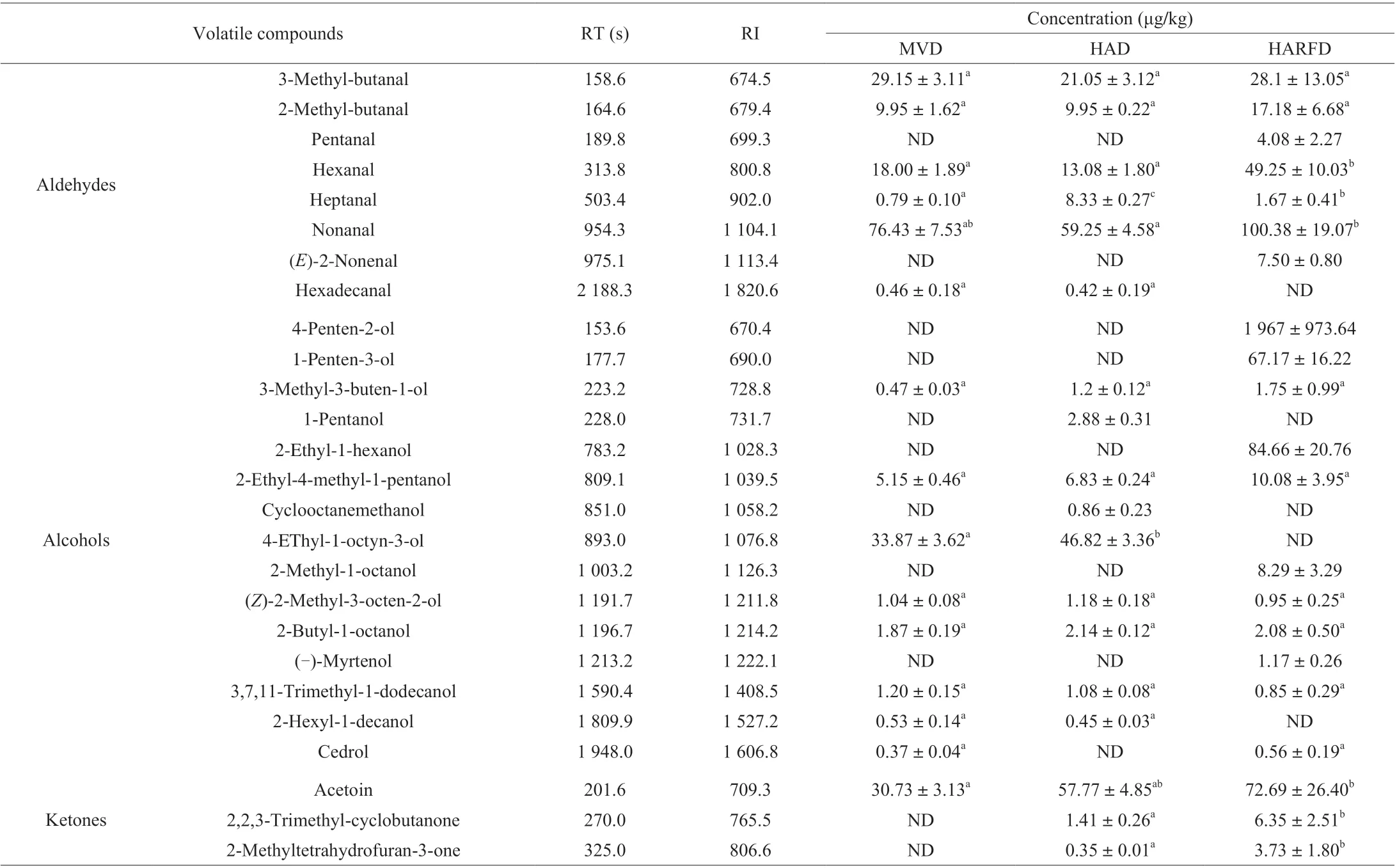
Table 5 Volatile compounds identified in MVD, HAD and HARFD T. obscurus.
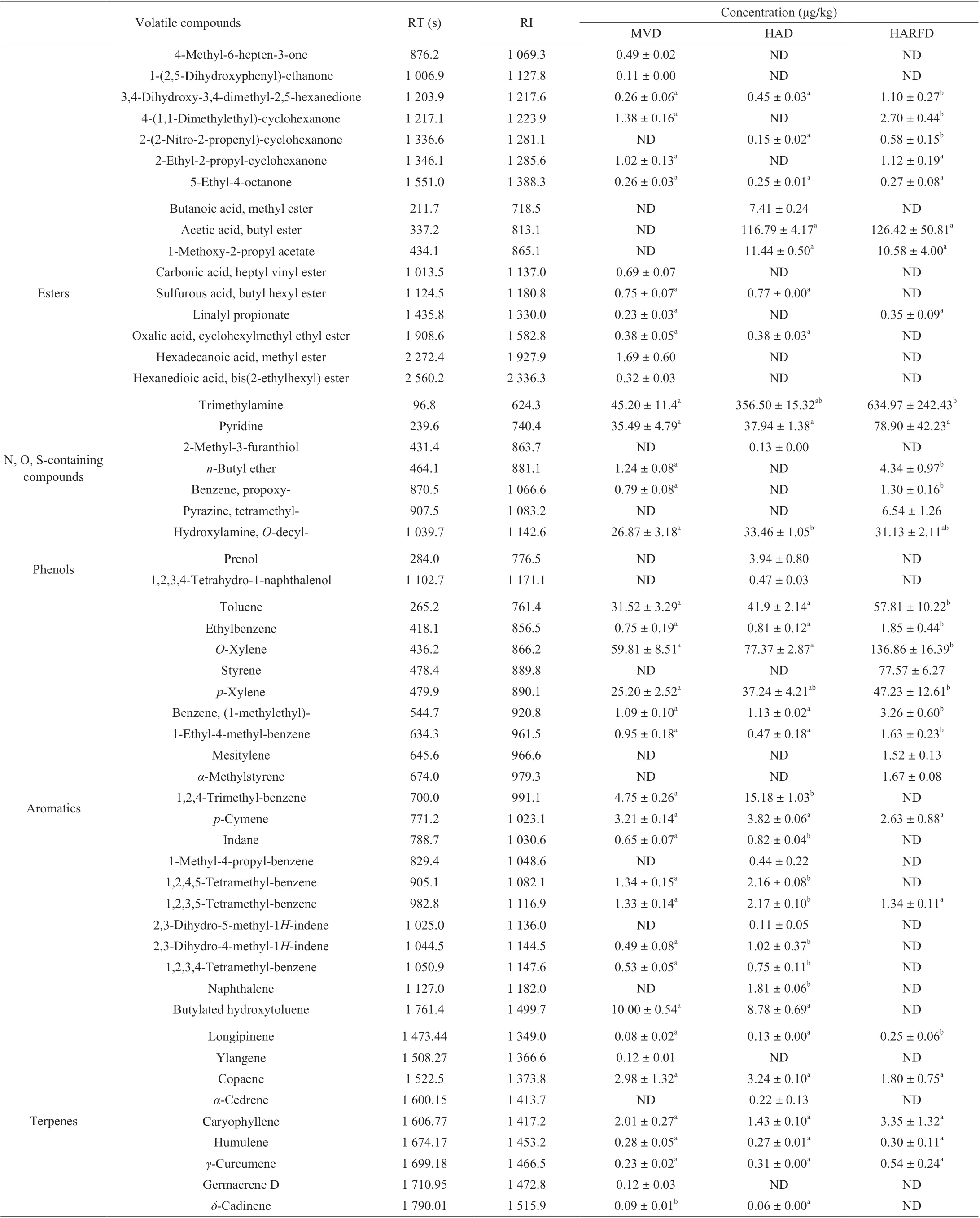
Table 5 (Continued)
Ketones are produced by oxidation of unsaturated fatty acids or Strecker degradation of amino acids [43]. Acetoin, with a sweet and buttery odor, was the major ketone and may contribute to the aroma profile of three driedT. obscurusbecause of its low odor threshold [41].The other cycloketones with branched chains were not reported inT. obscurusbefore, and their effect on aroma needs further researches.
Esters are generated by the esterification of alcohols and carboxylic acids, and the esters formed by short-chain or long-chain acids provide fruity or fatty odor, respectively [41]. The number of esters in MVD group was higher than that in the other two groups,which may be due to the decomposition of heat-sensitive compounds caused by high temperature in HAD and HARFD groups [5].Hexadecanoic acid methyl ester, which imparts a “green” odor, was observed in cookedT. obscurus[37]. In our study, hexadecanoic acid methyl ester was only detected in MVD group, indicating that it may be one of the grassy flavor contributors to MVDT. obscurus.
With regard to N, O, S-containing compounds, trimethylamine with a characteristic of fishy widely exists in seafood [7,44]. The highest content of trimethylamine was found in HARFD group,followed by HAD and MVD groups. Pyridines are produced by the oligomerization of reactive carbonyls and ammonia [45]. Here only pyridine was observed in our study, and there was no significant difference existed among the three dried groups (P< 0.05). Pyrazines are generated from Millard reaction and contribute the “grill” flavor to products [5,46]. Tetramethyl pyrazine only existed in HARFD group,this phenomenon can be explained by the Maillard reaction due to the local high temperature of fish muscle during HARFD. 2-methyl-3-furanthiol with meaty and roasted aroma and a low odor threshold [47]was only detected in HAD group.
Generally, hydrocarbons may contribute to little aroma since their high perception thresholds [48]. But researchers underline the aroma-enhancing-role of several aromatic hydrocarbons due to their relatively low odor threshold values [49].O-Xylene andp-xylene were the major aromatic aldehydes in three driedT. obscurus, it was reported that the former presented fruit-like and candy note, the latter presented smoked-phenolic note [46]. In addition, terpenes were considered as fresh, herbal and lemon [49], which may be related to the grassy and fishy notes of driedT. obscurus.
3.4 Sensory evaluation results
Twelve descriptors were developed during training sessions(Fig. 2a). The appearance included yellowness, greenness, redness and looseness; the odor included fishy, fish fragrance, crab roe like,fatty, roasted aroma, earthy, grassy and rubbery. Looseness was highest in MVD group due to the visible pores produced during the microwave process, and relatively low looseness scores indicated the dense structure was observed in HAD and HARFD groups. As shown in Fig. 2a, the yellowness and redness scores of HAD and HARFD groups were higher than MVD group, and the highest green was found in MVD group, which was consistent with results of the colorimeter (3.1).
Roasted aroma (pleasant burnt and roasted) was perceived strongest in HAD group, which might because heptanal (nutty and burnt aroma) occupied the main location in HAD group. The intensity of fish fragrance (pleasant cooked fish meat aroma) in HAD and HARFD groups was higher than that in MVD group. According to the result of GC-TOFMS, 2-methyl-3-furanthiol (meaty and roasted aroma) was only found in HAD group, which might be the reason why the roast aroma of HADT. obscurushad the highest score. MVD group had the highest intensity of fishy and grassy. Trimethylamine generally contributes to fishy odor, however, its content in MVD was the lowest, indicating that the fishy odor might not be caused by trimethylamine alone. It was reported that hexanal gave grassy, leafy,and green flavor to farmedT.obscure[37]. But HARFD group had the highest content of hexanal. The hexadecanoic acid methyl ester with grassy characteristic was only observed in MVD group, which might contribute more to the grassy odor in driedT. obscuruscompared with hexanal.
The relationship between attributes and three dried samples was carried out by PCA. Fig. 2b showed that PC1 and PC2 complained 84.66% and 15.34% of the total variance, respectively. HARFD and HAD groups were positioned on the negative side of PC1, the former was associated with fish fragrance and crab roe-like while the latter was associated with yellowness, roasted aroma, redness and fatty. The MVD group was located at the positive side of PC1 and was most associated with the looseness, fishy, grassy and earthy.
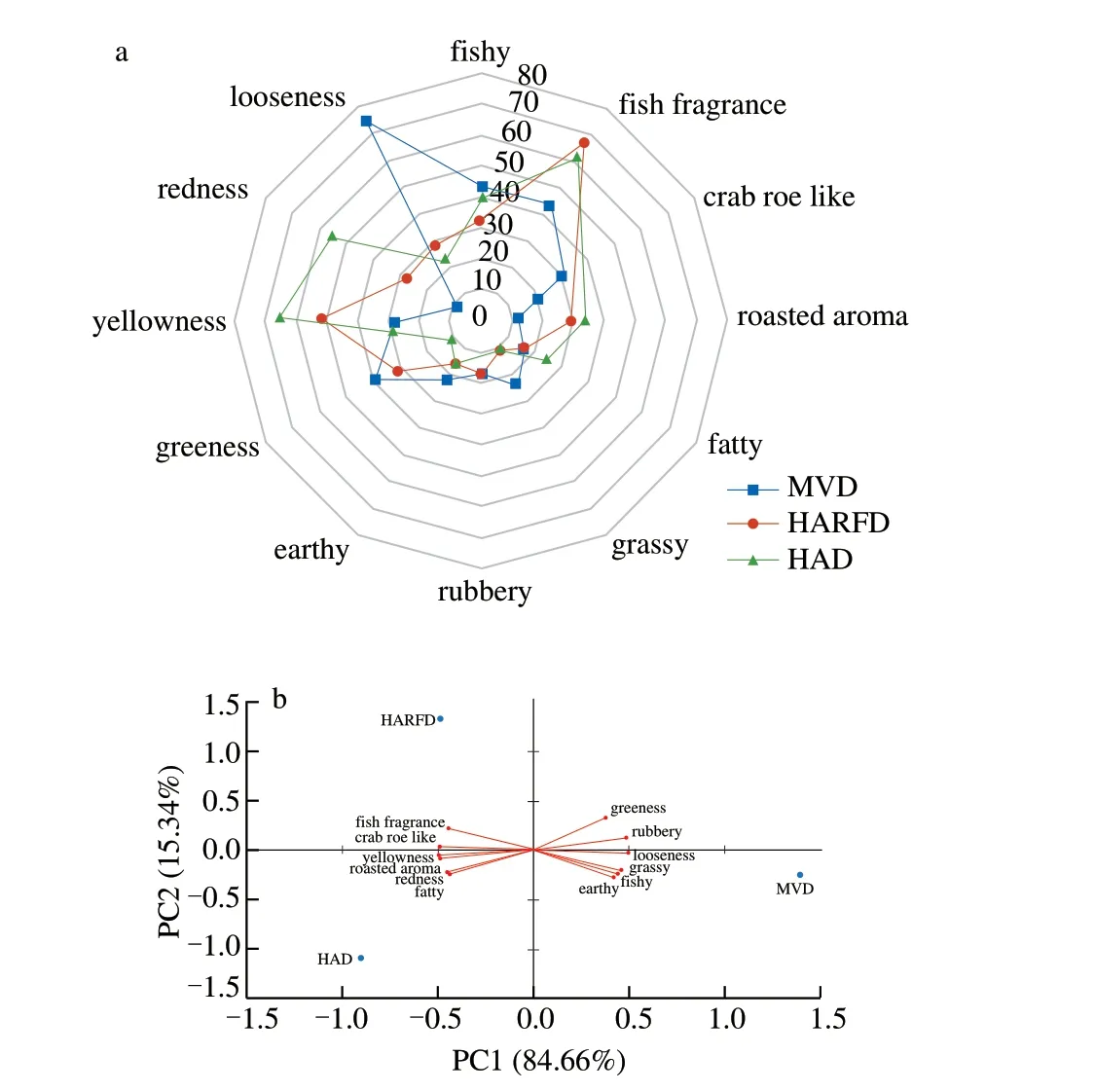
Fig. 2 Visualized QDA profiles and PCA analysis. (a) Sensory attributes intensity means from MVD, HAD and HARFD T. obscurus; (b) PCA biplot of MVD, HAD and HARFD T. obscurus and sensory attributes.
Maintaining or even improving the outstanding flavor of food is particularly important. Overall, HAD and HARFD could significantly improve the EUC values and endowT. obscuruswith higher intensity of pleasant aromas, such as fish fragrance, crab roe like and roasted aroma. By contrast, MVD may be not the optimum one due to the unsatisfactory EUC value and unpleasant odor such as fishy and earthy, though it had better rehydration and color retention.Compared with HARFD, HAD seems to have more advantages in industrial application due to the simple operation and energy-saving characteristics.
4. Conclusions
Rehydration, color, taste components (5’-nuclotides and free amino acids) and volatile compounds ofT. obscurusranged among different drying methods. HADT. obscuruspossessed the highest content of total FAAs, which was 1.5 and 3 times of HARFD and MVD groups, respectively. The EUC values of HARFD and HAD groups were about 2 times of MVD group. The QDA result indicated that HAD and HARFD could contribute pleasant flavor to driedT. obscurus. Considering the economic benefits, HAD is more applicable in industrial application. This study provides reference of improving the quality of driedT. obscurusin industrial application.
Conflict of interest
The authors declare that they have no known competing financial interests or personal relationships that could have appeared to influence the work reported in this paper.
Acknowledgements
This work was supported by The National Natural Science Foundation of China (32001824, 31972198, 31901813, 31901816,32001827), Startup Fund for Youngman Research at SJTU (SFYR at SJTU). The authors would like to thank all the panelists for experimental support.
Appendix A. Supplementary data
Supplementary data associated with this article can be found, in the online version, at http://doi.org/10.1016/j.fshw.2022.07.012.
杂志排行
食品科学与人类健康(英文)的其它文章
- Evaluation and selection of yeasts as potential aroma enhancers for the production of dry-cured ham
- Preserved egg white alleviates DSS-induced colitis in mice through the reduction of oxidative stress, modulation of inf lammatory cytokines,NF-κB, MAPK and gut microbiota composition
- Energy status regulated umami compound metabolism in harvested shiitake mushrooms (Lentinus edodes) with spores triggered to release
- Edible mushrooms as a potent therapeutics of subclinical thyroid dysfunction among adults, especially in obese individuals: a prospective cohort study
- Screening hepatoprotective effective components of Lonicerae japonica Flos based on the spectrum-effect relationship and its mechanism exploring
- Effects of the degree of oral processing on the properties of saliva-participating emulsions: using stewed pork with brown sauce as the model
